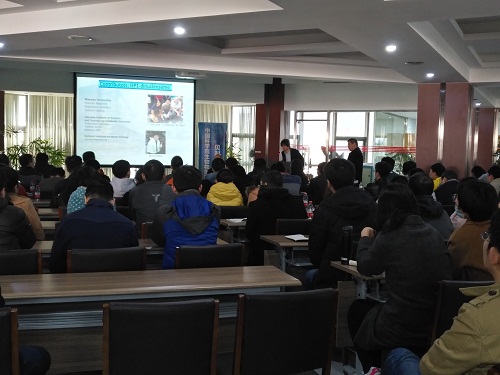Professor Hitoshi Kurumizaka from Waseda University of Japan Visited IBP and Delivered a BEI Shizhang Lecture
On 8th November, 2017, Professor Hitoshi Kurumizaka from Waseda University of Japan was invited by Professor Guohong Li of IBP to give a presentation titled " Structural and Biochemical Studies for Epigenetic Chromatin Regulation”. Many researchers and graduate students actively participated in this academic report.
During 1995-1997, Professor Hitoshi Kurumizaka engaged in postdoctoral research at the National Institute of child health and human development, the National Institutes of Health Hospital. During 1997-2003, he worked in RIKEN as a research scientist, then he was an associate professor at the Waseda University during 2003-2008. Even since, he worked as full professor at Faculty of Science and Engineering of Waseda University and as a visiting professor at City University of Yokohama. Professor Hitoshi Kurumizaka has been engaged in the dynamic regulation and function research of chromatin structure for a long time and has carried on the thorough exploration in homologous recombination, DNA damage repair and the interaction between DNA and protein.
Eukaryotic genomic DNA is compacted as chromatin stored in the nucleus. The nucleosome is the basic structural unit of chromatin. Nucleosomes are dynamic entities that slide and reposition along DNA by spontaneous or enzymatic remodeling processes. Consequently, a repositioned nucleosome collides with a neighbor nucleosome to form the intermediate “overlapping dinucleosome” (OLDN). They reconstituted overlapping dinucleosome with human histones H2A, H2B, H3.1, and H4 in the presence of the 250-bp DNA segment by the salt-dialysis method. They found that a H2A/H2B dimer was dropped from nucleosome to form the overlapping dinucleosome by ESI-MS and X-ray crystallography. Then they found OLDN located downstream of the transcription start site through genome-wide analysis.
In addition, the Kurumizaka’s lab has done significant work in heterochromatin structure. The structure of heterochromatin formed by HP1 dimer bridged H3K9me3 containing nucleosome is analyzed by ultracentrifugation, MNase digestion and Cryo electron microscopy (3D) reconstruction technique. The excellent work of Professor Hitoshi Kurumizaka has greatly promoted the understanding of heterochromatin structure, nucleosome remodelling and transcription regulation.
We have benefited a lot from the lecture, after that a number of researchers and students asked questions and conducted in-depth discussions with Professor Hitoshi Kurumizaka. Then Professor Hitoshi Kurumizaka and graduate students talked actively at the luncheon.



